Learn how to use AI tools to easily turn a passage or any type of text into well-structured comprehension questions.

Creating comprehension questions from different types of text (e.g., a passage or an excerpt) can be more time-consuming than it looks. You want questions that match your students’ grade level, align with learning objectives, and challenge them appropriately, all while keeping your lesson engaging. It’s easy to spend a lot of time tweaking questions to get them just right, and that’s where AI tools can really help.
In this tutorial, we’ll show you how to use AI to quickly generate reading comprehension questions from a passage. You’ll learn how to guide the AI so that the questions match your classroom needs, including balancing question types, aligning with standards, and even supporting students at different reading levels.
We’ll walk through the process step by step, from setting up your prompt to making small adjustments to the output to ensure it’s ready for your students. By the end, you’ll have a repeatable workflow that saves time and helps you create high-quality comprehension questions for any passage or excerpt or other types of text you choose. You’ll also learn how to use an AI comprehension question generator, which can make the entire process much easier.
To keep the process simple, we’re going to create a set of 10 reading comprehension questions for 5th grade students, based on a passage on Isaac Newton. Regardless of your passage topic or length, the strategy outlined here will be the same.

1. Head over to Monsha.
If you don’t have an account, you can easily register for free.
2. Select the Reading Comprehension Questions tool.
On your account page, you’ll see a list of different tools to create your teaching resources, from lesson plans to worksheets to quiz questions, and more. Click on See all tools, which will expand the list, and then select Reading Comprehension Questions.
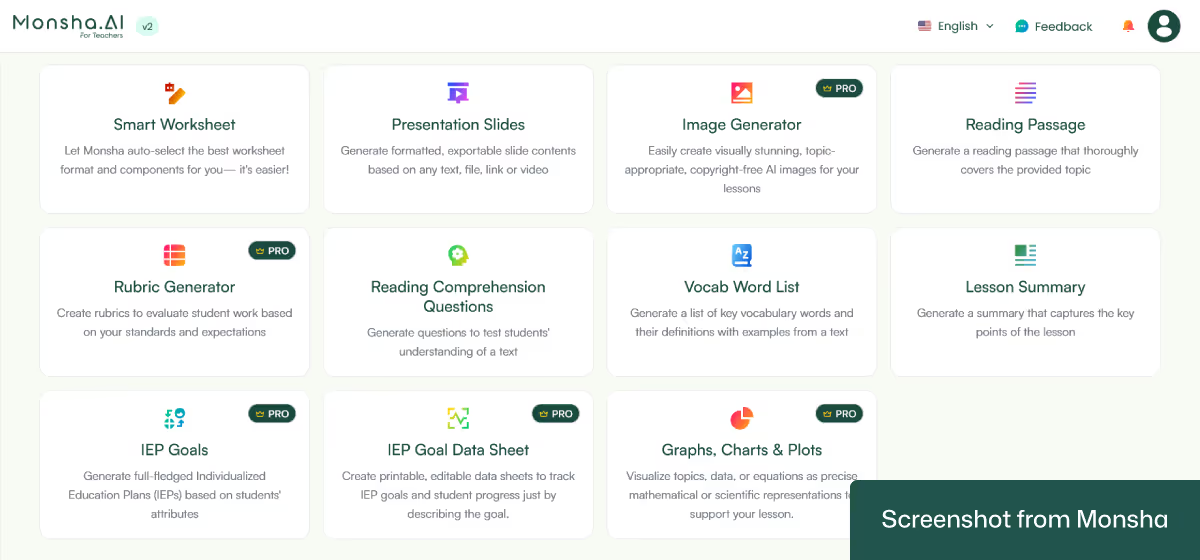
3. Configure your requirements and provide your reading passage or text.
On the Create Reading Comprehension Questions screen, you’ll find several options to set your requirements. Such as:

Configure these basic options first. Here’s how we set ours:

Now's the time to add your source text. Click on the Text option, and a window will pop up. That’s where you can paste your text or excerpt.
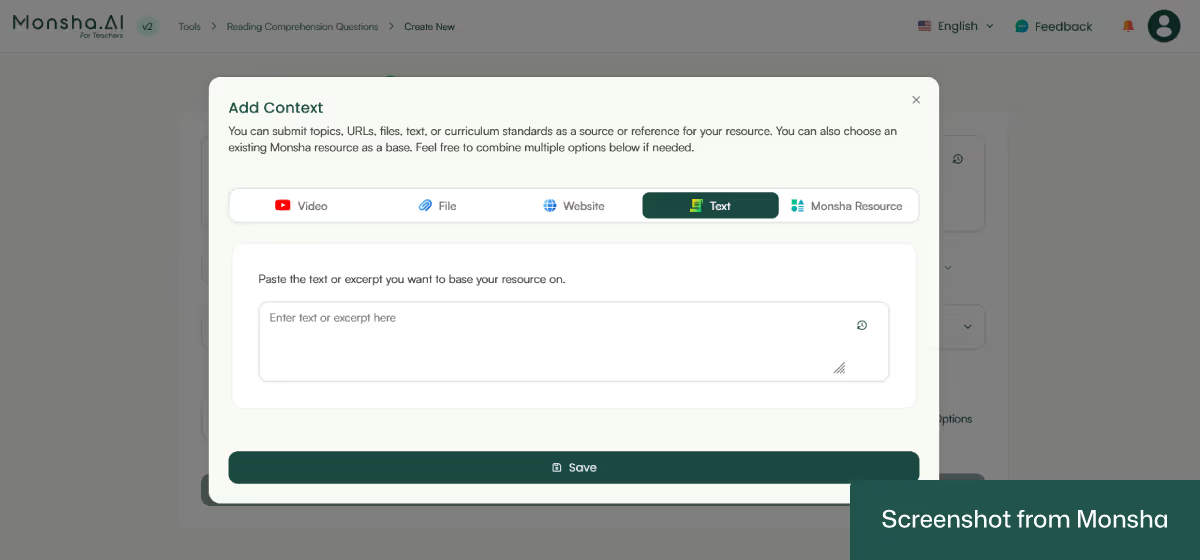
You’re all set!
By the way, there are a few more options that you can use to refine your configuration. For example, you can combine multiple source materials! You’ll also be able to assign your comprehension question set to a course, unit, or lesson. Use it if you plan your entire curriculum and create other resources with Monsha.
In case you need to adhere to specific curriculum standards or educational frameworks (e.g., Bloom’s Taxonomy), you can incorporate them as well!
What if you have more requirements? That’s where the “Describe your requirement…” text area can help. Just specify your needs there.
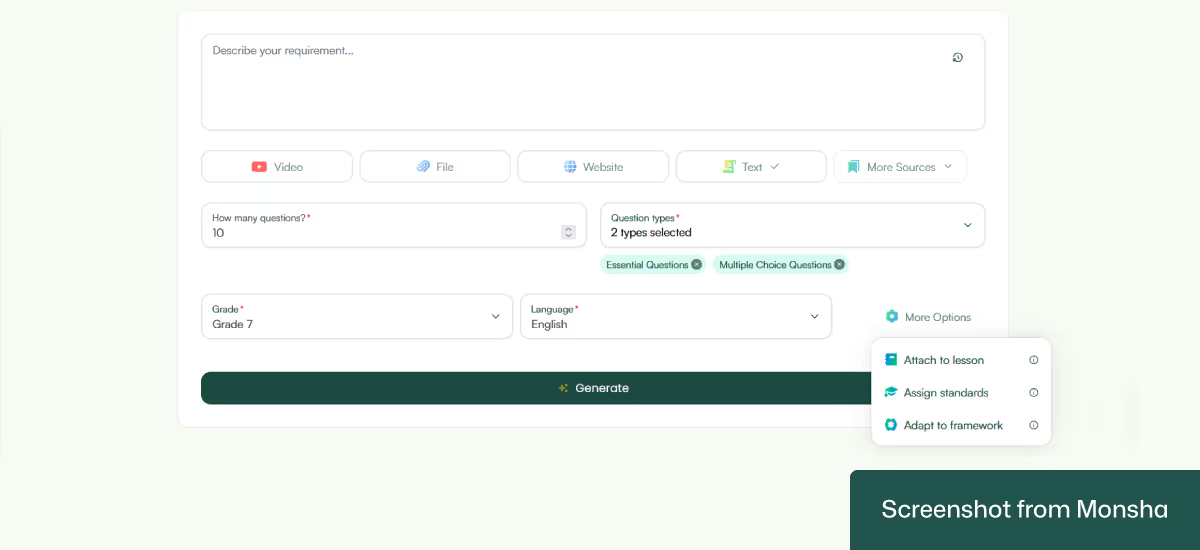
4. Click Generate.
And your comprehension questions will be ready in seconds!
The output we got includes both the passage and questions:
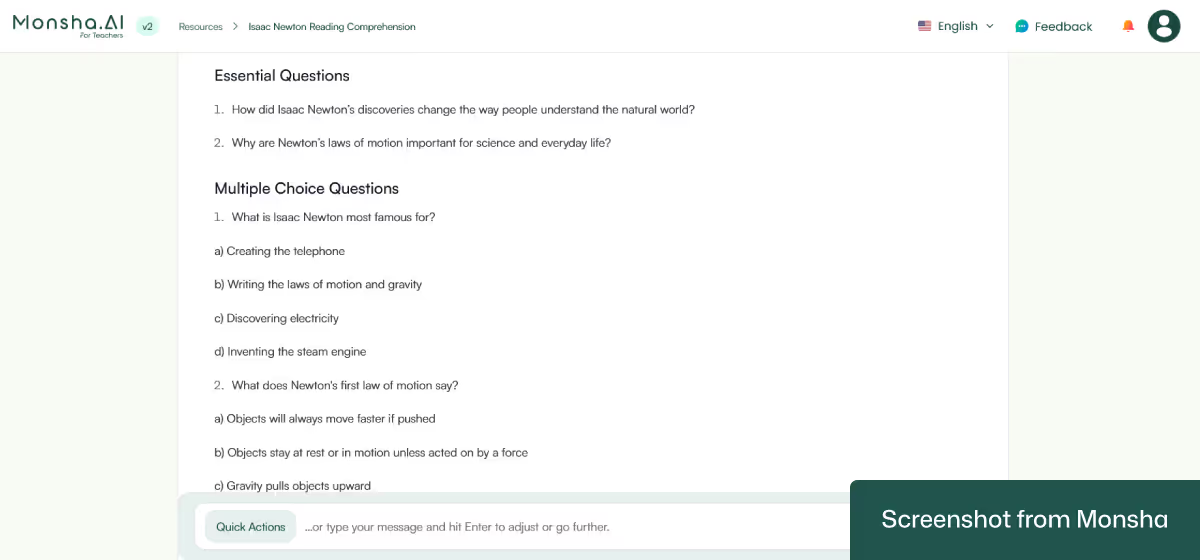
Just a quick note. You can follow the same steps to create comprehension questions from any source materials.
Generating comprehension question sets with Monsha is super easy, but that’s just the starting point. Here’s how you can make the most of the tool.
After generating your questions, you can tell Monsha to provide another version or include additional components. Just type in a simple prompt as if you’re chatting, and you’ll get an updated output. For example, the “Include learning objectives and suggest classroom activities I can use to inspire my students to learn more about Newton and other scientists.” prompt will regenerate the comprehension question set.

Here’s what we got by using the prompt:

In case you’re not sure how to structure the prompt, use the Quick Actions feature. To change the tone or difficulty level, for instance.

If needed, you can add new headings and rich content like images, bullet lists, tables, and more. This will reduce your dependency on third-party editing tools.
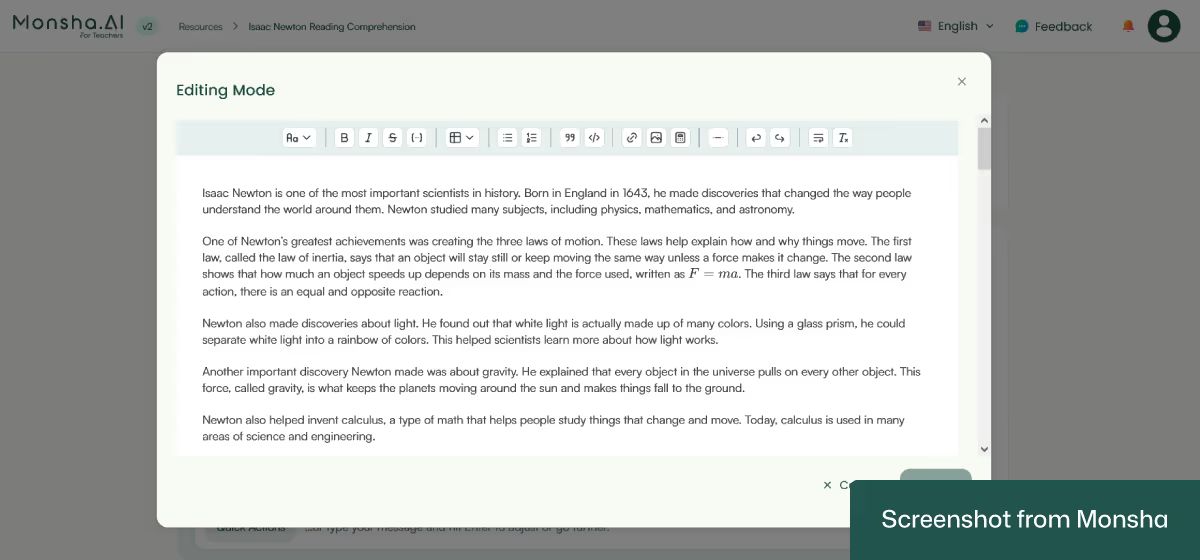
As you’ve seen in this tutorial, you can adapt your question set based on grade level, DOK levels, Lexile reading level, or Bloom’s taxonomy during the configuration. This option is available even after you get your output. You can translate the question set as well. So create as many versions as needed to teach multiple groups of students. This is how you can incorporate AI-powered differentiated instruction in your workflow without stressing about it.
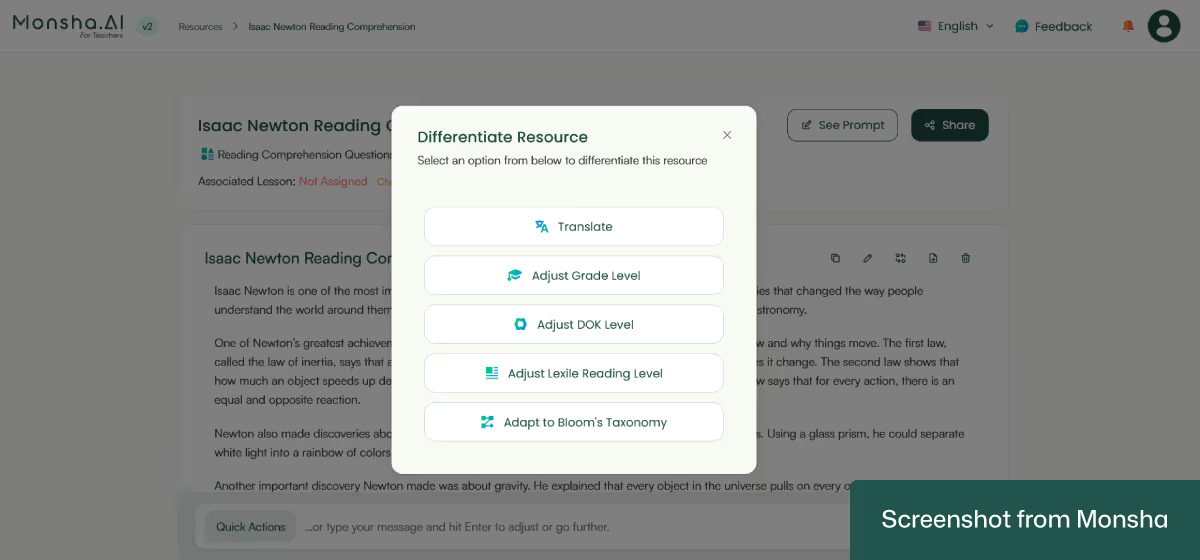
Save your reading comprehension questions in DOC, PDF, Google Forms, or other formats. You can also export them to well-known quiz platforms for teachers. The best part? No extra formatting required! Monsha automatically generates a properly formatted file for you. So you can just export your questions and upload it to the following options as needed:
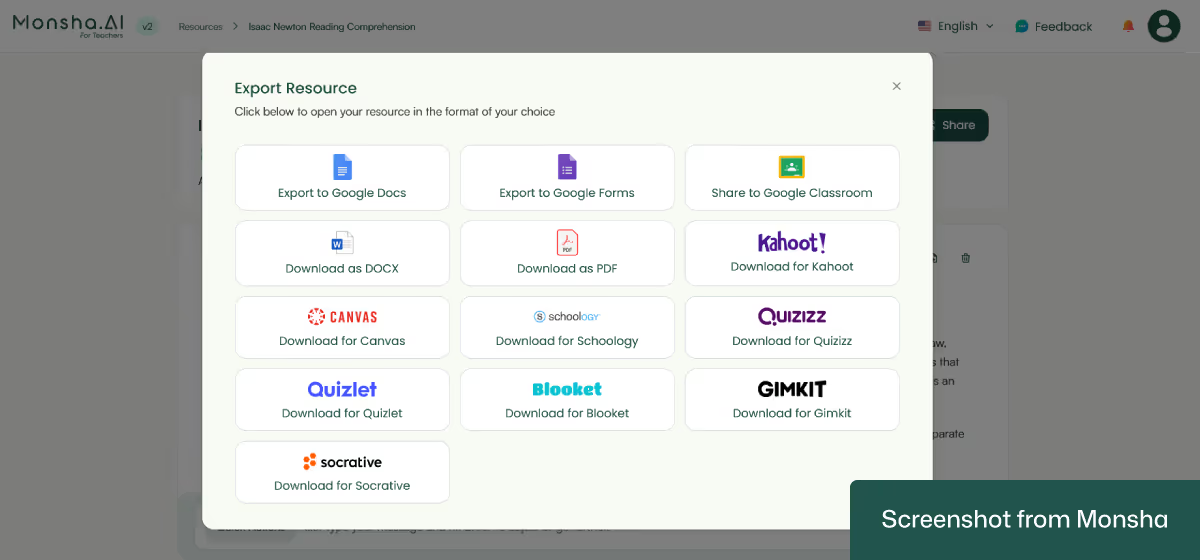
If you need to create more reading comprehension questions, you don’t have to start from scratch at all. Just use the same prompt.
One more thing. Your question set as well as any resource you generate with Monsha remain securely stored in your account. So you can use and update them whenever needed.
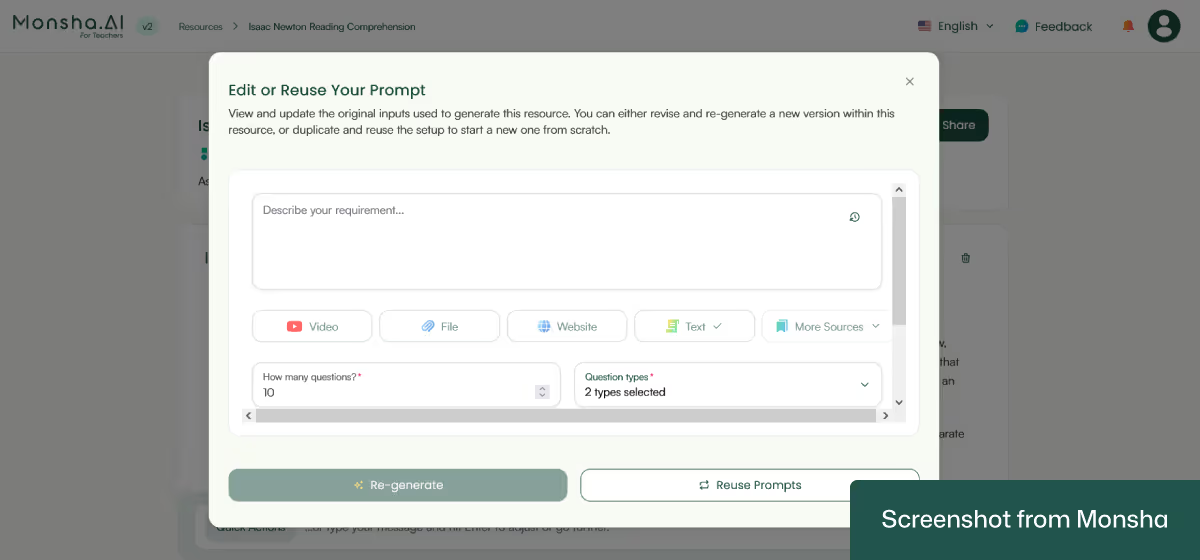
When you ask ChatGPT or any other general-purpose AI chatbots to generate comprehension questions, the way you give instructions makes a big difference. If you simply paste an excerpt and say “make some questions,” the output may be too generic, uneven in difficulty, or not aligned with your teaching goals. That’s why teaching-specific prompts matter. They guide AI tools to consider your grade level, your students’ reading abilities, and the standards you’re working with. Without that direction, the questions may look fine on the surface but won’t always serve your classroom needs.
You should think of AI chatbots as a teaching assistant who needs clear instructions. So be as specific as possible, just like you would explain the objectives to your assistant. For example, if you want to focus on inference skills for a Grade 6 group, you could tell the AI chatbot, “Create eight comprehension questions for this text. Four should be literal recall, three should be inferential, and one should encourage creative thinking. Make sure the wording matches Grade 6 reading level.” This level of detail ensures that the questions come back structured and useful.
By including details such as the number of questions, the balance of question types, and any differentiation needs, you make the output more practical. If you also add your learning outcomes, like “students should be able to summarize main ideas and make inferences”, the questions will feel more intentional rather than random. The more you anchor your prompt in classroom realities, the less time you’ll spend rewriting or adjusting the results later.
Let’s take a look at a prompt template that you can use to generate reading comprehension questions. We’ll include some practical examples as well. We’re leaving the text field empty on purpose so that you can use your own passages. In case you want to check out more examples, explore our AI prompt collection for teachers.
“Create a set of reading comprehension questions based on the following text/excerpt:
Text/Excerpt: [Paste text here]
Grade Level: [e.g., Grade 5]
Students’ Reading Level: [Below/At/Above grade level]
Curriculum Standards: [Insert e.g., Common Core, Cambridge, IB, National Curriculum]
Learning Objectives: [Insert objectives, e.g., “Students will identify main ideas, infer meaning, and analyze character motivations.”]
Desired Learning Outcomes: [Insert outcomes, e.g., “Students will answer literal, inferential, and evaluative questions with evidence from the text.”]
Types of Questions: [Multiple choice, short answer, open-ended, vocabulary-in-context, higher-order thinking]
Number of Questions: [e.g., 10 total: 4 multiple choice, 3 short answer, 2 inferential, 1 creative extension]
Differentiation Options: [e.g., Provide sentence starters, scaffolded vocabulary, tiered question sets for mixed abilities]
Special Notes: [e.g., Avoid culturally biased examples, include at least 1 question for students with ELL needs]”

“Create 8 comprehension questions for the following text: [Paste a short fable like “The Lion and the Mouse”].
Grade Level: Grade 3
Reading Level: At grade level
Curriculum Standard: Common Core Reading Literature
Objectives: Students will identify the moral of the story, recall key events, and infer character traits.
Outcomes: Students will answer literal and inferential questions with text evidence.
Question Types: 3 multiple-choice, 3 short-answer, 2 inferential
Differentiation: Include one simplified question for struggling readers and one challenge question for advanced readers.”
“Based on the excerpt from Anne Frank’s Diary [insert passage], create 10 comprehension questions.
Grade Level: Grade 7
Reading Level: Mixed (ELL students included)
Curriculum Standard: IB MYP Language and Literature
Objectives: Students will analyze perspectives, infer emotional tone, and understand historical context.
Outcomes: Students will demonstrate critical reading by answering literal, inferential, and evaluative questions.
Question Types: 4 literal, 3 inferential, 2 evaluative, 1 vocabulary-in-context
Differentiation: Provide one scaffolded multiple-choice question for ELLs and one open-ended reflection for higher-level students.”
“Using the article [Paste a short article on climate change], generate 12 comprehension questions.
Grade Level: Grade 10
Reading Level: At/Above grade level
Curriculum Standard: NGSS literacy in science
Objectives: Students will extract key scientific information, interpret data from text, and evaluate solutions.
Outcomes: Students will summarize key points and critically assess arguments with evidence.
Question Types: 5 multiple-choice, 3 short answer, 2 inferential, 2 critical-thinking
Differentiation: Provide vocabulary support (definitions in context) for ELLs and an extension “research question” for advanced students.”
One of the biggest challenges with using general-purpose AI chatbots to generate comprehension questions is that they don't automatically know all the details of your classroom. Even if you find a way to clearly explain all your requirements, it takes time to experiment. This back-and-forth can be frustrating if you’re already busy. That’s why it’s valuable to have a solution that makes your process more repeatable, reliable, and effective. If you’re considering such a solution, give Monsha a try.

AI for Teachers
We’re the Monsha Team—a group of educators, engineers, and designers building tools to help teachers combat burnout and get back to life.. Our blogs reflect real classroom needs, drawn from conversations with educators around the world and our own journey building Monsha.
Join thousands of educators who use Monsha to plan courses, design units, build lessons, and create classroom-ready materials faster. Monsha brings AI-powered curriculum planning and resource creation into a simple workflow for teachers and schools.
Get started for free